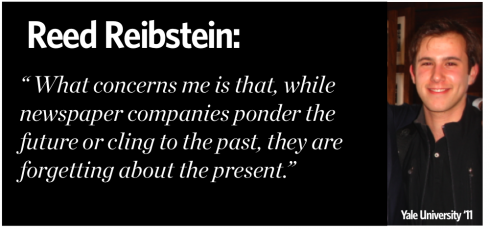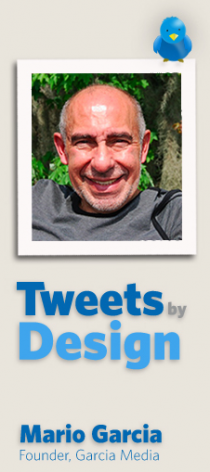TAKEAWAY: Reed Reibstein (Yale University ‘11) has completed his second summer internship with Garcia Media. I have asked him to summarize his experience and offer us a young perspective on how he sees the state of the media, circa fall 2009.
Let’s hear it from a 21-year-old who reads newspapers

Often, when I discuss the state of the media today, I refer to several types of readers: printnets, digital natives, promiscuous users and traditional readers.
It is difficult to place our summer intern, Reed Reibstein, into any of these categories, as he would probably qualify for all of the above. At 21, and a junior at Yale University, Reed represents the best of his generation: educated, media savvy, tech oriented to the max, and a voracious consumer of information. He definitely qualifies also in the role of what Rupert Murdoch describes as “digital natives”—-the Nintendo generation born with a remote control or stick in their hands.
However, Reed also has a passion for typography, and even a greater appreciation for what happens when type lands on a page (or screen), and I have enjoyed our exchanges tremendously, having learned much from him. Indeed, someone born in 1988 can bring someone born in 1947 up to speed. Reed has managed to do that, and, of course, all of you who read my blog know that he has become a strong presence.
The good news: although Reed is back at Yale, involved with production of the Yale Daily News, while tackling his coursework and doing all those things that typical college students do, he has promised to continue to offer us his insights, send us those links to fascinating sources, and, of course, remain involved in the several projects that he started during the summer, but that will launch throughout the year. A win win situation for all.
He will tell you all about his experiences here.
I can summarize my experience of working with him in one sentence: We all need the presence, energy and curiosity of a 21-year-old media consumer next to us so that we can make wiser decisions about the projects which we might otherwise approach from perspectives no longer so valid.
I let Reed tell you his own perspective of his experience with us. More importantly, don’t miss what this young man has to say about the state of the media, and newspapers particularly.
My internship with Garcia Media: a global tour
Last summer, I helped to redesign my college newspaper, had a chance to discuss projects in England and Nigeria, and visited Ottawa for a weeklong intensive design session. I thought this was a busy and stupendous few months, but it does not compare to the remarkable time I have had in my second summer internship with García Media.
What I learned by working with Mario from late May to the end of August is so extensive that I cannot begin to recount everything I was able to do. Here is a quick list of some of what I worked on this summer:
*Designed a newspaper supplement for teens and tweens; vibrant colors, quick reads, and a sense of fun were the keys.
*Learned all about a foreign writing system – its history, styles, and many differences from the norms of the Latin script.
*Created the story structures (centerpiece stories, secondary pieces, short reads, and briefs) that will anchor a newspaper’s design.
*Determined the differences in attitude between a tabloid and a broadsheet.
*Researched the standard European online advertising units – in case you were wondering, “medium rectangles” (300 pixels by 250) are the most common.
*And, as you perhaps read about on this blog, I absorbed an incredible amount of information about typography from my time participating in the short course at the University of Reading.
‘Newspapers aren’t going away any time soon’
I learned one more thing this summer, not from any one place but from the multitude of perspectives that appear every day with increasing frequency: Despite what some might argue, newspapers aren’t going away any time soon, and they’re certainly not dying. Evolving (in the Darwinian sense) is more like it. Just as species respond to pressures in their environment by adapting, so newspapers today are finding that tactics that once sustained them are no longer effective and must be replaced. But whereas evolution in nature occurs over a long period of time, without any awareness of what is happening by those involved, today’s journalists are responding to a rapid paradigm shift – and they must consciously choose how to react.
Eventually, the expectation for media organizations will no longer be to produce a printed newspaper seven days a week. There is a lot of talk about what the new standard will be – a weekend newspaper with the website taking over during the week, an electronic reader that constantly streams news from around the world, or a smart phone that delivers news targeted to your schedule. More than likely, it will be to use all three of these – and several that do not yet exist.
What concerns me, though, is that while newspaper companies ponder the future or cling to the past, they are forgetting about the present. For the next five to ten years, newspapers will have an increased Internet presence, but they will still remain on newsprint. But at the moment, few newspapers create much of a link between the screen and the page. In print, most employ a simple link next to articles with a Web component – directing readers to a specific Web address at best, unhelpfully telling readers to “See more content online” at worst. These print links are better than nothing, but not by much, as the onus for viewing online content is on the reader. Newspapers don’t encourage you to read the print edition while near a computer, so how many people really take the initiative to go to the newspaper website to search for a video or type in a 30-character URL? While some may interact with both platforms, the clumsiness of switching between interfaces creates two audiences, one largely reliant on a media organization’s print offering and one on their website. And as a newspaper’s audience splinters, the possibility of print complementing Web offerings and Web enhancing print evaporates.
The page as an information-delivery device
Editors have to think of the page as an information-delivery device. The central question thus becomes, “How can we make the printed newspaper work better – on its own and as it interacts with the Internet?”. Design-thinking leads to a few ideas. Use keywords in your print Web links that take readers straight to the content they want on the. Try experimenting with printing techniques – tear-off summaries of today’s news, posters and ads that extend outside your tabloid or broadsheet page, or thicker paper stock. Staple your pages as the Scandinavians do; your readers will thank you for it. Make the search bar on your website the centerpiece, and echo that with the print navigation; for greater dividends, incorporate the aforementioned keyword concept. Create online experiences meant to work in conjunction with a printed article, perhaps by filming introductory movies for each section of a longer piece or designing a quick reference guide to people and places mentioned in the story.
Too many editors nowadays seem content for the scope of their “engagement” with the Web to be placing all their stories online and starting a Twitter account. Instead, journalists should work on creating a media organization for our hybrid print/online culture. Designing new interfaces and making use of social media websites is important work, but before envisioning the newspaper of the future, try making one for the present.
The Impact of the Compact
Pure Design: Download entire section: Type
Download entire first section of Pure Design: Words
Now that I have fully presented the first of six sections of Pure Design on TheMarioBlog, I am offering the entire initial section, “Words,” available for download—all 33 pages of it. This may be useful for those of you saving or printing out Pure Design and will be done following each of the remaining sections. At the end of our journey through words, type, layout, color, pictures, and process, I will publish the entirety of Pure Design in one file.

Who is Jacky?
Jacky belongs to Frank Deville. The Luxembourg-based pooch is an “avid reader” of the German newspaper, Bild Am Sonntag. Every Sunday Jacky picks stories and interesting graphics in Bild Am Sonntag , the German newspaper.
WAN’s World Trends 2009 Report

The 2009 edition of World Press Trends from WAN/IFRA is now available. I always like to review this report for its complete information on global circulation, advertising and online trends in our industry. All countries in the world where daily newspapers are published are covered in the publication.
This year the WAN/IFRA folks have decided to publish a print version but only make the book available on pdf.
Those interested go:
http://www.wan-press.org/forms/wpt2009.html

Follow me at www.twitter.com/tweetsbydesign
Follow the Marios

Two Marios. Two Views.
Follow Mario Jr. and his blog about media analysis, web design and assorted topics related to the current state of our industry.
http://garciainteractive.com/
Visit Mario Sr. daily here, or through TweetsByDesign (www.twitter.com/tweetsbydesign)
In Spanish daily: The Rodrigo Fino blog
:
To read TheRodrigoFino blog, in Spanish, go:
https://garciamedia.com/latinamerica/blog/
TheMarioBlog posting #358